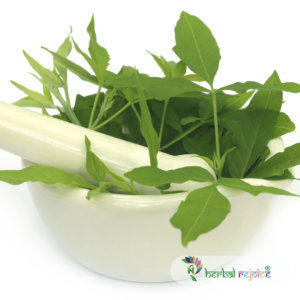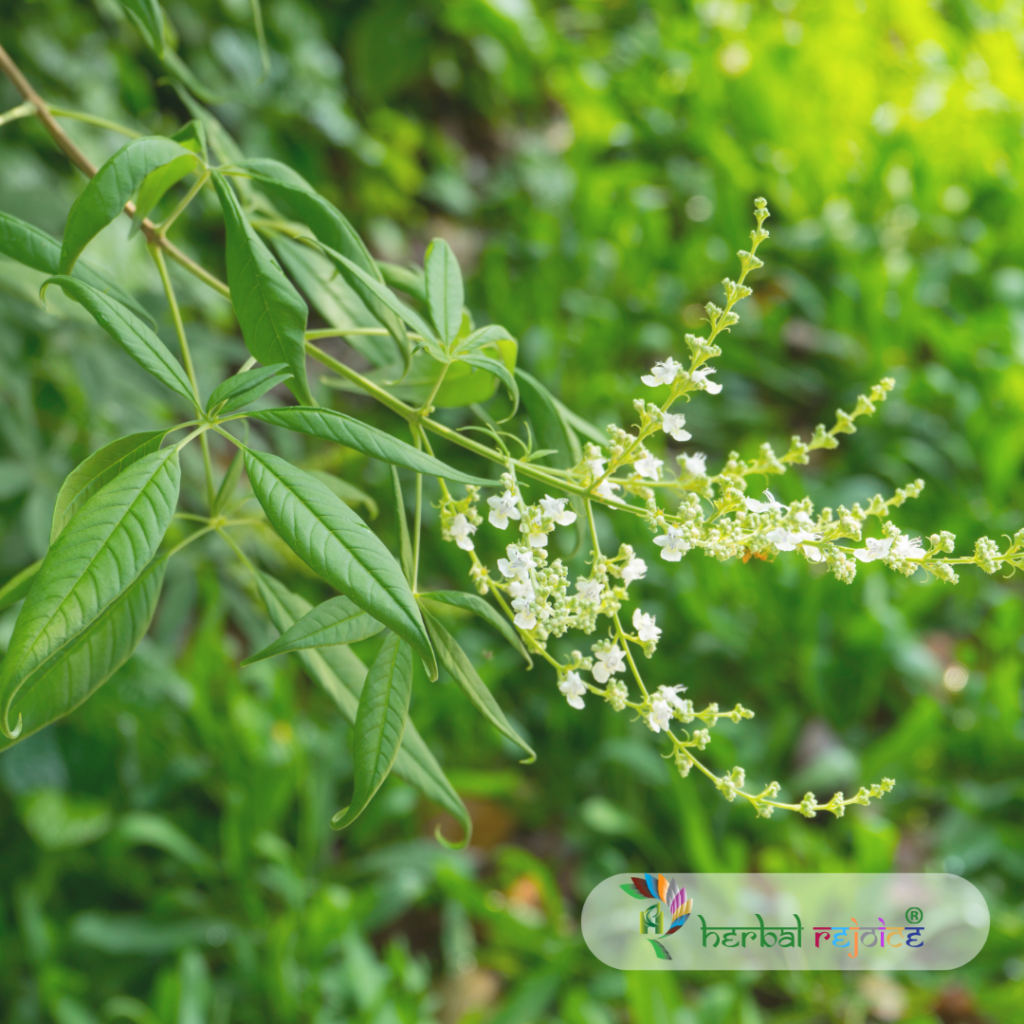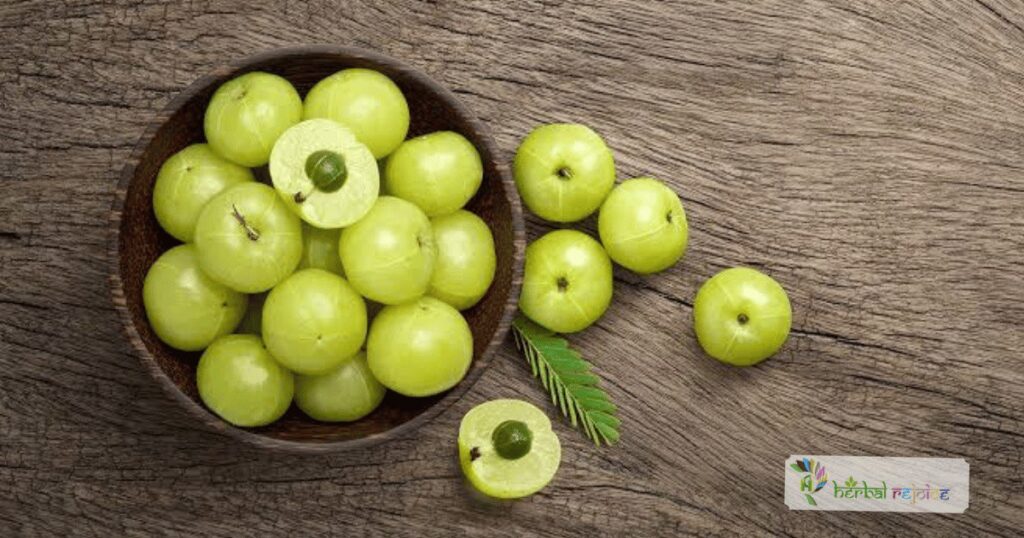Introduction
Vitex negundo Linn., also known as Five-leaved Chaste tree, is a plant that belongs to the Verbenaceae family. It can be found throughout India in the warmer zones, and it can grow up to 900 m in the North-western Himalaya.
In English, it is called Five-leaved Chaste tree. In Ayurvedic medicine, it is known as Nirgundi, Shephaalikaa, Sindhuka, Sindhuvaara, Suvahaa, Sugandhikaa. In Unani medicine, it goes by Sambhaalu and Fanjankisht. In Siddha/Tamil medicine, it is known as Nochi, Nalla Nochi, Vellai Nochchi, and Nirkundi.
Medicinal Uses
This plant has various medicinal properties. Its seeds are prescribed in spermatorrhoea and for promoting spermiogenesis in Unani medicine. They are also given as a rejuvenating tonic for retarding old age and for retaining and promoting virility in Ayurvedic medicine. The leaf has anti-inflammatory and analgesic properties, and it can help remove foetid discharges and worms from ulcers. The flowers have astringent, febrifuge, and antidiarrhoeic properties, and they are prescribed for liver complaints. The oil can be applied to sinus and scrofulous sores.
In Ayurvedic medicine, the leaf (and root) is recommended for excessive vaginal discharges, oedema, skin diseases, pruritus, helminthiasis, rheumatism, and puerperal fever, according to The Ayurvedic Pharmacopoeia of India. A water extract of the leaves has been found to exhibit anti-inflammatory, analgesic, antihistaminic, membrane stabilizing, and antioxidant activities when administered to rats. Another study found that the methanolic extract of the leaves showed remarkable antihistaminic activity.

Chemical Constituents
The leaves contain iridoid glycosides, isomeric flavanones and flavonoids, casticin, and the glucosides luteolin-7-glucoside and alphaD-glucoside of a tetrahydroxy monomethoxy flavone. The dried powder of the roots contains hentriacontane, beta-sitosterol, beta-sitosterol aetat, and stigmasterol. An alcoholic extract of the root has shown 40-60% antiimplantation activity with no antiovulatory effect in rats. Flavone vitexicarpin, isolated from the leaves, exhibited broad cytotoxicity in a human cancer cell line panel. Additionally, two pentacyclic triterpenoids (betulinic acid and ursolic acid), aliphatic alcohol (n-hentriacontanol), beta-sitosterol, and p-hydroxybenzoic acid have been isolated from the leaves. The seeds contain p-hydroxybenzoic acid, 5-oxyisophthalic acid, glucose, and the triterpene vitextriterpene. The seeds have also been found to contain several anti-inflammatory triterpenoids and flavonoids. A flavanone called 5,7,3-trihydroxy-6,8,4-trimethoxyflavone exhibited anti-androgenic activity in adult mice and dogs.
Dosage
The recommended dosage for the leaf is 10-15 ml of juice, and for the root, it is 10-12 ml of juice, as stated in API, Vol. III.
Conclusion
In conclusion, Vitex negundo Linn. has a wide range of medicinal uses and can be beneficial for various health conditions. It is important to follow the recommended dosage and consult with a healthcare professional before using it for therapeutic purposes.
Frequently Asked Questions
What is Vitex negundo Linn.?
Vitex negundo Linn., also known as Five-leaved Chaste tree, is a plant that belongs to the Verbenaceae family.
What are the common names of Vitex negundo Linn.?
In English, it is called Five-leaved Chaste tree. In Ayurvedic medicine, it is known as Nirgundi, Shephaalikaa, Sindhuka, Sindhuvaara, Suvahaa, Sugandhikaa. In Unani medicine, it goes by Sambhaalu and Fanjankisht. In Siddha/Tamil medicine, it is known as Nochi, Nalla Nochi, Vellai Nochchi, and Nirkundi.
What are the medicinal properties of Vitex negundo Linn?
Vitex negundo Linn. has various medicinal properties. Its seeds are prescribed in spermatorrhoea and for promoting spermiogenesis in Unani medicine. The leaf has anti-inflammatory and analgesic properties, and it can help remove foetid discharges and worms from ulcers. The flowers have astringent, febrifuge, and antidiarrhoeic properties, and they are prescribed for liver complaints. The oil can be applied to sinus and scrofulous sores.
What conditions can the leaf (and root) of Vitex negundo Linn. be used for?
According to The Ayurvedic Pharmacopoeia of India, the leaf (and root) is recommended for excessive vaginal discharges, oedema, skin diseases, pruritus, helminthiasis, rheumatism, and puerperal fever.
What are the benefits of a water extract of the leaves of Vitex negundo Linn. in rats?
A water extract of the leaves has been found to exhibit anti-inflammatory, analgesic, antihistaminic, membrane stabilizing, and antioxidant activities when administered to rats.
What anti-implantation activity has been observed in rats with an alcoholic extract of the root of Vitex negundo Linn.?
An alcoholic extract of the root has shown 40-60% anti-implantation activity with no anti-ovulatory effect in rats.
What compounds have been isolated from the leaves of Vitex negundo Linn.?
The leaves contain iridoid glycosides, isomeric flavanones and flavonoids, casticin, and the glucosides luteolin-7-glucoside and alphaD-glucoside of a tetrahydroxy monomethoxy flavone. Flavone vitexicarpin, two pentacyclic triterpenoids (betulinic acid and ursolic acid), aliphatic alcohol (n-hentriacontanol), beta-sitosterol, and p-hydroxybenzoic acid have also been isolated from the leaves.
What compounds have been found in the dried powder of the roots of Vitex negundo Linn.?
The dried powder of the roots contains hentriacontane, beta-sitosterol, beta-sitosterol aetat, and stigmasterol.
What anti-androgenic activity has been observed in adult mice and dogs with a flavanone found in the seeds of Vitex negundo Linn.?
A flavanone called 5,7,3-trihydroxy-6,8,4-trimethoxyflavone exhibited anti-androgenic activity in adult mice and dogs.
What is the recommended dosage for the leaf of Vitex negundo Linn.?
The recommended dosage for the leaf is 10-15 ml of juice.
What is the recommended dosage for the root of Vitex negundo Linn.?
The recommended dosage for the root is 10-12 ml of juice.
What precautions should be taken when using Vitex negundo Linn. for therapeutic purposes?
It is important to follow the recommended dosage and consult with a healthcare professional before using it for therapeutic purposes.
Can Vitex negundo Linn. be helpful for skin diseases?
Yes, according to Ayurvedic medicine, the leaf (and root) of Vitex negundo Linn. is recommended for skin diseases.


